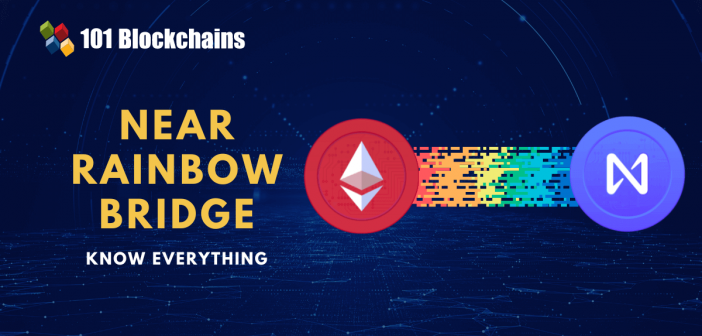Learn how blockchain truly works, master key definitions, and uncover what makes smart contracts so "smart." Dive into the fundamentals, gain valuable insights, and start your blockchain journey today!

- Guides
James Howell
- on November 15, 2022
What is NEAR Rainbow Bridge and How do they work?
Cryptocurrencies and applications of blockchain technology have achieved formidable levels of popularity in recent times. Many popular blockchain networks, such as Bitcoin and Ethereum, experienced critical issues in scalability owing to the gradually increasing demand. The NEAR Rainbow Bridge is an effective solution for scalability, among many others, which has made an impact on the world of decentralized applications and systems as the Ethereum blockchain becomes one of the preferred networks for building decentralized applications and NFTs.
However, the increasing number of transactions leads to network congestion, thereby leading to higher gas fees and, subsequently, more transaction costs. Therefore, users and developers are more likely to experience critical troubles in creating and accessing web3 applications. The NEAR protocol has emerged as one of the prominent solutions for scalability, and the Rainbow Bridge is a significant part of the protocol. The following discussion will help you learn more about NEAR protocol and the Rainbow Bridge, along with an explanation of their functionalities.
Become a certified blockchain expert with 101Blockchains’ Blockchain Certifications designed to propel your career in blockchain technology.
Defining the NEAR Protocol

Before you look for answers to “What is Rainbow Bridge in the near protocol?” you need to learn about NEAR protocol. The protocol is a layer 1 blockchain network, which uses blockchain sharding technology to achieve scalability. It depends on smart contracts and the Proof of Stake consensus mechanism for securing the network. Launched in 2020, the protocol’s founders, Alex Skidanov and Illia Polosukhin brought an interesting model. The NEAR Collective would operate the protocol in the form of a community-operated cloud infrastructure, which would help in hosting decentralized apps.
In addition, the NEAR platform also features a variety of programming languages and tools alongside smart contracts featuring cross-chain functionality for helping developers in creating dApps. The appeal of the rainbow bridge crypto solution would also depend on a simpler onboarding process. Furthermore, the NEAR protocol also offers human-readable account names rather than cryptographic wallet addresses. It is also renowned for its carbon neutrality, as it grabbed the Climate Neutral Product Label award in 2021.
Get familiar with the terms related to blockchain with Blockchain Basics Flashcards.
Working of NEAR Protocol
You might be curious about “How does the NEAR Rainbow Bridge work?” and you can find the answer with the working of the NEAR protocol. The protocol sets a clear advantage over other types of blockchains for developing smart contracts, such as Polkadot, Ethereum, and EOS, through the addition of different features in the ecosystem. NEAR protocol can offer significant advantages in the form of Nightshade sharding, Rainbow Bridge and Aurora. Here is an overview of the significance of these features in the NEAR protocol.
-
Nightshade Sharding
The core technology underlying the NEAR blockchain is Nightshade, a sharding technology to enable efficient data processing. Sharding is the process of splitting the workload for processing transactions throughout different validator nodes. As a result, all nodes would manage a fraction of the network transactions, thereby ensuring higher transactions per second or TPS.
It complements the NEAR Rainbow Bridge for enabling scalability. Nightshade leverages block producers alongside validators for processing transaction data in parallel to each other throughout multiple shards. Every shard produces a fraction for the next block, with each fraction known as a chunk. The chunks are subjected to processing and storage on the NEAR Protocol for finalizing transactions.
Nightshade can theoretically enable the management of millions of transactions per second without affecting performance. According to network conditions, it can ensure dynamic splitting and merging of shards according to network traffic and resource usage. Upon achieving high capacity, the number of nodes in the network would increase and maintain overall efficiency while enabling low transaction fees.
In the case of sharding, validators do not have to engage in competition for the next block according to the size of their stakes. The NEAR protocol leverages an election mechanism known as the Thresholded Proof of Stake (TPoS) for the selection of validators. TPoS would work like an auction, which involves a large pool of potential validators interested in staking the NEAR token.
According to the number of tokens validators interested in staking through a signed transaction, validators would be selected for the Nightshade sharding. TPoS could help in determining the minimum threshold for turning into a validator for each epoch. Prospective validators who stake more than the specified threshold would have the chance of being selected.
Want to get an in-depth understanding of crypto fundamentals, trading and investing strategies? Enroll Now in Crypto Fundamentals, Trading And Investing Course.
-
Rainbow Bridge
The next important feature of the NEAR protocol is the Rainbow Bridge. It is a major application of the NEAR protocol, launched in 2021. Interestingly, the Rainbow Bridge token list includes ERC-20 tokens, wrapped tokens, stablecoins, and NFTs. You can swap these tokens between Ethereum and the NEAR protocol, and it helps developers, as well as users, manage the benefits of better throughput and lesser fees across the NEAR protocol. The Rainbow Bridge is completely decentralized and permissionless. It also offers the flexibility for bridging tokens by sending them directly to the NEAR wallet from Metamask as well as other web3 wallets.
The understanding of “What is Rainbow Bridge in NEAR protocol?” becomes easier, especially in terms of usability. You can start using the bridge by depositing ERC-20 tokens in Ethereum smart contract. Without the facility for direct token transfer between networks, the tokens would have to be locked and removed from circulation. New tokens must be created on the protocol to represent the original tokens, thereby ensuring constant value for the total circulating supply among both blockchain networks.
Generally, NEAR Rainbow Bridge transactions take almost 1 to 2 seconds for confirmation, with costs lower than $1. On the other hand, users may incur more costs for reverting the token back to Ethereum. The final value of the transaction would rely on the existing gas prices and traffic on the Ethereum blockchain.
-
Aurora
Another striking feature of the NEAR protocol is the layer 2 scalability solution, Aurora. It completes the trinity of scalability with NEAR protocol by helping developers increase the scalability and interoperability of their apps, alongside offering lower transaction costs. The NEAR protocol can capitalize on the Rainbow Bridge Aurora combination to deliver plausible improvements in scalability. Most important of all, the NEAR protocol assumes that Aurora could host thousands of transactions per second. On top of it, Aurora could ensure a block confirmation time of almost 2 seconds.
The two primary aspects of the design of Aurora include the Aurora Bridge and the Aurora Engine. The Aurora Engine is an EVM or Ethereum Virtual Machine on the NEAR protocol. It offers compatibility with Ethereum alongside all the tools accessible within the Ethereum ecosystem.
As a result, developers could start working on the NEAR blockchain without knowledge of new development tools or rewriting their dApps. On the other hand, the Aurora Bridge features similarities to Rainbow Bridge for the seamless transfer of ERC-20 tokens to and from Ethereum and the NEAR protocol blockchain. Users could also pay their transaction fees on Aurora by using ETH.
-
NEAR Token
The noticeable component in the working of the NEAR protocol would refer to the Rainbow Bridge token or NEAR token. It is the native token for the protocol and all other applications on the NEAR blockchain. As an ERC-20 token, the maximum supply for the NEAR token has been estimated at around 1 billion.
The applications of the token primarily include payments for transactions and storage fees. In addition, smart contract developers could receive a specific portion of the transaction fees generated by their smart contracts. The mechanism for the scarcity of NEAR tokens involves burning the remaining transaction fees.
Token holders could also participate in staking on the NEAR wallet to earn desired rewards. The Rainbow Bridge crypto token helps owners in validating nodes for earning rewards, amounting to almost 4.5% of the total token supply. The token owners could also engage in governance for the NEAR network by voting on different decisions alongside the submission of proposals pertaining to the products and the platform.
Interested in Smart Contracts? Checkout our FREE presentation on Examples Of Smart Contracts
Significance of the Rainbow Bridge

The introduction to different features of the NEAR protocol showcase the position of Rainbow Bridge in the protocol’s ecosystem. The existing blockchain landscape includes many applications and protocols transforming into a multi-chain architecture. Developers could capitalize on multi-chain architecture for the advantages of composability, shorter confirmation times, and better efficiency with protocols like NEAR.
The answer to “How does the NEAR Rainbow Bridge work?” can show how developers could enjoy the interoperability of assets. The lower transaction times and transaction fees could help in bridging tokens to the NEAR blockchain. With the ability for seamless migration of assets to the platform, NEAR also offers a low-cost, highly efficient, and developer-friendly protocol.
The popularity of the Rainbow Bridge has brought many notable tokens to the NEAR protocol. In the first phase, Rainbow Bridge opened up the gates for the free flow of assets between Ethereum and NEAR blockchain. The popular examples in the Rainbow Bridge token list include stablecoins such as USDT and DAI. It also supports the transfer of DEX tokens such as UNI (Uniswap) and wrapped tokens such as WBTC or WETH. The Rainbow Bridge also supports lending tokens such as Aave and Compound, as well as service company tokens.
Want to learn the basic and advanced concepts of Stablecoin? Enroll in our Stablecoin Fundamentals Masterclass Now!
The Architecture of Rainbow Bridge
Another promising highlight to learn about how Rainbow Bridge works is its architecture. The architecture of Rainbow Bridge could help you learn what actually happens in practice. An overview of the technical components in the architecture of the bridge can serve as a clear impression of its working.
-
Rainbow Bridge User Interface
The first component in using Rainbow Bridge refers to the UI. It is the official website of the NEAR protocol, where users can ensure interactions with the bridge for transferring assets among networks.
-
LiteNode
The next component in the architecture of Rainbow Bridge is the LiteNode. It is a blockchain node for the NEAR Rainbow Bridge and provides storage for block headers only. As a result, it could ensure a dramatic reduction of storage space. Subsequently, the implementation of LiteNode as two different smart contracts. One of the smart contracts stays on the Ethereum network for storing NEAR block headers, while the smart contract on the NEAR protocol works for storing Ethereum block headers.
-
Relayers
Relayers are another crucial element within the architecture of the Rainbow Bridge, especially for maintaining the LiteNodes. The LiteNodes are smart contracts and cannot go through automatic updates. On the contrary, relayers could help the LiteNodes by periodically reading blocks from a particular chain, followed by communicating them to the LiteNode, operational on the other platform. With each update, the LiteNode on NEAR goes through the update across each Ethereum block. The low gas fees on NEAR, alongside a flexible update frequency, are the crucial value advantages associated with Relayers.
-
Connectors
The Connectors in Rainbow Bridge give out a lot about the meaning of the name itself. Connectors are the smart contracts for Rainbow Bridge, which specify the logic related to cross-chain management for a specific asset. The Connectors exist in pairs, just like the LiteNodes. Interestingly, the capabilities of Rainbow Bridge crypto transfer depend largely on connectors. If you can program the relevant Connectors, you can transfer any data or asset through the Rainbow Bridge.
Start your blockchain journey Now with the Enterprise Blockchains Fundamentals
Working of Rainbow Bridge
The introductory overview of the NEAR protocol and the Rainbow Bridge, alongside its architecture, showcase the notable value advantages of the bridge. On the other hand, you must have curiosity regarding how it works and the important benefits you can find. Bridge protocol could remove the need for trusting anyone other than the security of the connected blockchain networks. Any individual could learn how to use NEAR protocol for deploying a new bridge or using an existing bridge. Furthermore, it can facilitate the maintenance of an existing bridge without obtaining approval from others.
One of the answers to “What is Rainbow Bridge in NEAR protocol?” would refer to the three significant traits. The bridge works as a permissionless, trustless, and generic protocol for bridging two different blockchain networks. On top of it, the bridge also showcases preparedness for future changes in protocols on the connected chains.
The Rainbow Bridge has been tailored to offer easy and simple accessibility to all users. It features an intuitive design alongside the facility of a crypto faucet for direct onboarding of crypto tokens from Metamask. The two most important and expected costs in the working of Rainbow Bridge include,
- Costs for sending assets to NEAR from the Ethereum blockchain, which land up at around six minutes or 20 blocks, amounting to almost $10 on average.
- If you want to send assets back to Ethereum, the time required may amount to almost 16 hours. You must also look at the average cost of the transaction at around $60.
The best highlight of Rainbow Bridge would focus on the interoperability roadmap of the NEAR protocol. As a generic protocol for bridging two blockchain networks, it can open up many opportunities for the combination of other blockchain networks.
Want to have a deeper knowledge of Ethereum? Enroll now in our Ethereum Development Fundamentals Course.
Bottom Line
The NEAR protocol is a powerful scalability solution, which offers shard, layer 2 scalabilities, as well as a bridge. Unlike other token bridges, the NEAR Rainbow Bridge has developed strong compatibility with a wide variety of blockchain networks. Most important of all, the NEAR protocol has also delivered a trustless, developer-friendly environment with higher efficiency and lower transaction costs. Rainbow Bridge can serve as one of the benchmarks for future solutions offering interoperability among blockchain networks. Imagine using ETH on another blockchain without any restriction. Learn more about NEAR protocol and scalability challenges for the web3 arena.
*Disclaimer: The article should not be taken as, and is not intended to provide any investment advice. Claims made in this article do not constitute investment advice and should not be taken as such. 101 Blockchains shall not be responsible for any loss sustained by any person who relies on this article. Do your own research!






